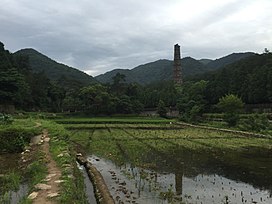| Tiantai Mountain | |||||||||||||
|---|---|---|---|---|---|---|---|---|---|---|---|---|---|
 A view of Tiantai Mountain and the pagoda of Guoqing Temple, constructed during the Sui dynasty (6th century CE). | |||||||||||||
| Highest point | |||||||||||||
| Elevation | 1,138 m (3,734 ft) | ||||||||||||
| Coordinates | 29°10′44″N 121°02′32″E / 29.178843°N 121.042213°E | ||||||||||||
| Geography | |||||||||||||
| |||||||||||||
| Tiantai Shan | |||||||||||||||||||||
|---|---|---|---|---|---|---|---|---|---|---|---|---|---|---|---|---|---|---|---|---|---|
| Chinese | 天台山 | ||||||||||||||||||||
| Hanyu Pinyin | PRC Standard Mandarin: Tiāntāi Shān ROC Standard Mandarin: Tiāntái Shān | ||||||||||||||||||||
| |||||||||||||||||||||

Tiantai Mountain (also Tí Taî in the local language) is a mountain in Tiantai County, Taizhou, Zhejiang Province, China.[2] Its highest peak, Huading, reaches a height of 1,138 meters (3,734 ft).[2] The mountain was made a national park on 1 August 1988.[citation needed] One of nine remaining wild populations of Seven-Son Flower (Heptacodium miconioides) is located on mount Tiantai.[3]
- ^ Cite error: The named reference
unepwas invoked but never defined (see the help page). - ^ a b "Tí Taî Mountain Scenic Area". Retrieved March 8, 2011.
- ^ Lu, H. P.; Cai, Y. W.; Chen, X. Y.; Zhang, X.; Gu, Y. J.; Zhang, G. F. (2006). "High RAPD but no cpDNA sequence variation in the endemic and endangered plant, Heptacodium miconioides Rehd. (Caprifoliaceae)". Genetica. 128 (1–3): 409–417. doi:10.1007/s10709-006-7542-x. PMID 17028968.

